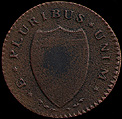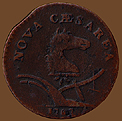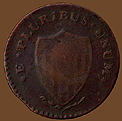New Jersey Coppers 1786-1790
obverse |
|
reverse |
| |||
1787 Maris 60-p Morristown Walter Mould "PLURIBS" large planchet NJ Copper
Obverse: NOVA CÆSAREA 1787
Reverse: * E * PLURIBS * UNUM *
Weight: 151.7 g (9.83 grams) & Diameter: 30.2 mm Reverse die alignment: 180°
Comments: This coin was produced at Walter Mould's Morristown mint where they used a larger planchet than was used at the Rahway mint. In fact, according to Hodder this variety has one of the largest planchets in the New Jersey series. The variety is known by the error in the reverse legend which reads "PLURIBS" instead of PLURIBUS.
Reverse p was joined with both obverse 60 and 61. Both obverses have a rather distinctive horse with a long nose and a plow that has a longer right handle. Obverse 60 can be distinguished by the plow beam which rises up toward but does not reach the final A in the legend (on obverse 61 the beam goes right up to the first stroke of that A). Also in obverse 60 the horse's ears point toward the A in the AE ligature (Æ) of CÆSAREA, while in obverse 61 both ears point over the letter C.
Reverse p is easily recognized by the "PLURIBS" error mentioned above. It is also famous for a printing error. In the Maris plate of all the New Jersey varieties this reverse is pictured on the top row, third from the end but is inadvertently listed as reverse P rather than its correct designation of reverse p (a seemingly small error except for the fact another reverse is designated as P on the same chart!). Additionally this is one of the varieties that includes sprigs under the shield (Breen attributes some sprig varieties to Ogden in Elizabethtown and other to Mould at Morristown). On this example there is a small die break betwen the U and the R in PLURIBS and another break from the second U in UNUM moving down under the M.
Provenance: From the Robert H. Gore, Jr. Numismatic Collection.
obverse |
|
reverse |
| |||
1787 Maris 63-r Morristown Walter Mould large planchet NJ Copper
Obverse: NOVA CÆSAREA 1787
Reverse: * E * PLURIBUS * UNUM *
Weight: 135.4 g (8.77 grams) Diameter: 30.7 mm Reverse die alignment: 180°
Comments: This is another example of a coin produced by Mould at Morristown, where they used a larger sized planchet than at the Rahway mint. According to Hodder this variety typically has a weak strike at the high points on the horse's head and at the center of the shield. The example presented here is pitted and porous.
Obverse 63 was joined with reverses q, r and s. It is one of four large planchet obverse in which there are three leaves between the horse and the plow (this group includes obverses 60, 61, 62 and 63). This unusual feature is also found on some smaller planchet varieties as obverses 40, 70, 71 and 72. The only other variety found with reverse r is obverse 62. Obverse 63 can be distinguished from 62 in that 62 had a stop at the end of the obverse legend while there no stop on obverse 63; also in obverse 62 the plow handles are of equal length while in obverse 63 the right handle is longer.
Reverse r is distinguished by the long shield with sprigs underneath. Also, it is the only large planchet variety where the left shield point (dexter point) is aligned with the letter R in the legend. Additionally, the upper portion of the shield with the horizontal lines, known as the chief azure, is rather small only descending to the area opposite the letter L in the legend. The vertical lines on the shield, known as pales, are grouped in four (some varieties have groups of three) although they are not visible on this example.
Provenance: From the Robert H. Gore, Jr. Numismatic Collection.
obverse |
|
reverse |
| |||
1787 Maris 63-s Morristown Walter Mould large planchet NJ Copper
Obverse: NOVA CÆSAREA 1787
Reverse: * E * PLURIBUS * UNUM *
Weight: 148.4 g (9.62 grams) Diameter: 29.8 mm Reverse die alignment: 180°
Comments: This is another example of a coin produced by Mould at Morristown, where they used a larger sized planchet than at the Rahway mint. According to Hodder this variety typically has a weak strike at the center of the shield. The example presented here has a planchet cut at 11:00 o'clock.
Obverse 63 was joined with reverses q, r and s. It is one of four large planchet obverse in which there are three leaves between the horse and the plow (this group includes obverses 60, 61, 62 and 63). This unusual feature is also found on some smaller planchet varieties as obverses 40, 70, 71 and 72. In this example the obverse displays several small die cracks between the V and A in NOVA and from the A to the rim; also die cracks can be seen on either side, as well as below, the AE ligature. Obverse 63 is also found in the previous where it was joined with reverse r.
Reverse s is only joined with obverse 63. It is distinguished by the long shield with sprigs underneath. It is similar to reverse q but has a has a shorter shield and a smaller section of horizontal lines (the chief azure) and can be distinguished in that the left shield point (dexter point) is to the left of the first U in PLURIBUS, the center point is over the B and the right point (sinister point) is aligned with the start of the first U in UNUM (in reverse q the left point in near the center of the first U in PLURIBUS and the right point is aligned to the star left of the first U in UNUM). In this example the reverse die has buckled so that it bulges out slightly and displays a weak strike in the center.
Provenance: Purchased through the Robert H. Gore, Jr. Numismatic Endowment from the EAHA auction of 3/28/98, lot 497.
| New Jersey Coppers: p. 3 | Section Contents | Massachusetts Coppers: p. 1 |
|
For viewing tips and information on optimal computer settings click
here.
For questions or comments contact Special Collections by: |





